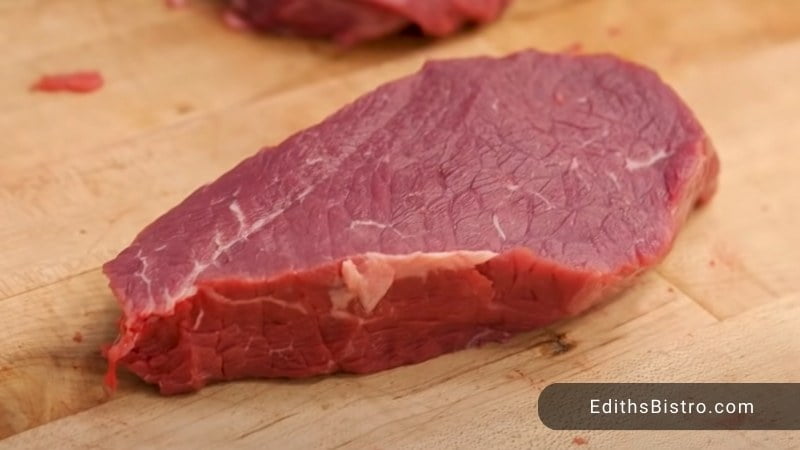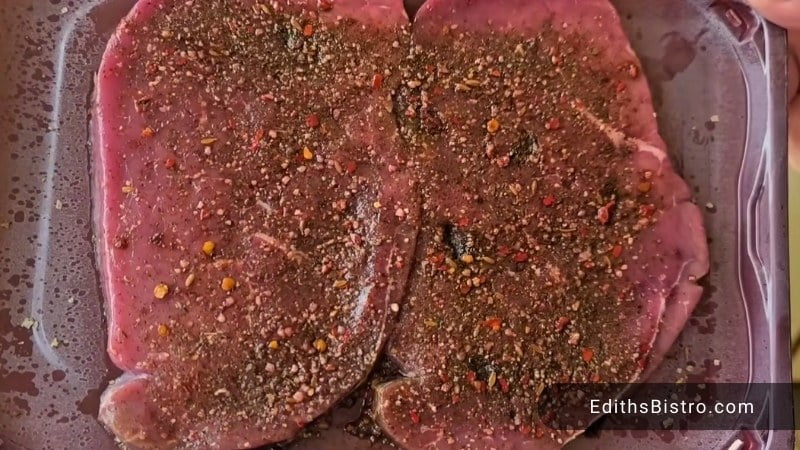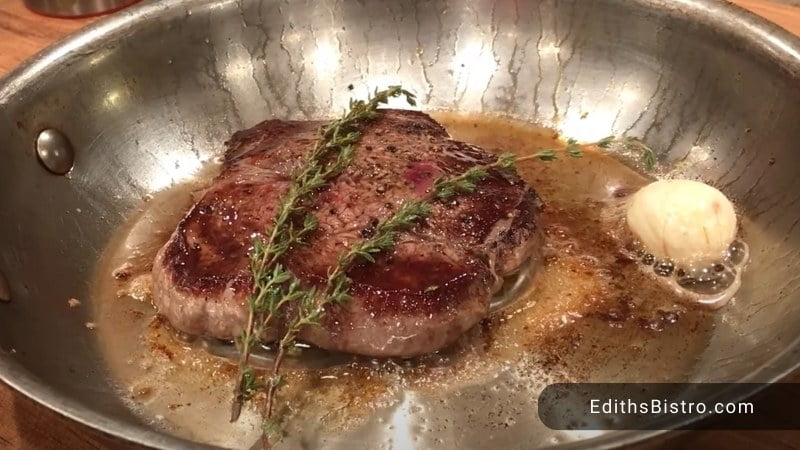Have you ever come across the term “ranch steak” and wondered what sets it apart from other cuts of beef? Ranch steaks, often overlooked in favor of more popular cuts, have a unique flavor profile and texture that can elevate any meal. This comprehensive guide will dive deep into ranch steaks, exploring their characteristics and best preparation methods.
What Is Ranch Steak?
Ranch steak is a cut of beef that originates from the cow’s shoulder muscle, specifically from the center closer to the rib area, known as the chuck roll. It is often referred to as the “boneless chuck shoulder center cut steak,” “shoulder center steak,” or “chuck steak.”
Ranch steak is typically a lean and boneless cut. Characterized by its rich and beefy flavor, this cut has minimal marbling. While often overlooked, it is rich in flavor and offers a robust protein profile.
And despite its inherent toughness compared to loin or rib cuts, its versatility shines when properly prepared, making it perfect for grilling, stews, stir-fries, or marinated dishes. Its affordability and hearty taste make it a hidden gem in the culinary world.

Steps To Perfectly Marinade Ranch Steak
Seasoning and marinating are crucial for bringing out the best in a ranch steak. Since it’s a leaner cut, infusing it with flavors ensures every bite is delicious and juicy. Here are steps to perfectly season and marinate a ranch steak:
- Preparation: Begin by patting your ranch steak dry with paper towels to remove any excess moisture. This helps the marinade adhere better and ensures proper searing when cooking.
- Basic Seasoning: Lightly sprinkle both sides of the steak with coarse salt and freshly cracked black pepper. This simple seasoning acts as the base layer for flavor.
- Creating the Marinade: In a mixing bowl, combine ingredients that balance acidity, saltiness, sweetness, and aromatics. A basic marinade might include:
- Acid: Lemon juice, vinegar, or wine (helps tenderize the meat)
- Oil: Olive oil or another preferred oil (helps distribute flavors and prevents sticking during cooking)
- Sweetness: Honey, maple syrup, or brown sugar (balances the acid)
- Aromatics and Herbs: Minced garlic, chopped rosemary, thyme, or cilantro
- Additional Seasonings: Soy sauce, Worcestershire sauce, or Dijon mustard can add depth of flavor
- Applying the Marinade: Place the steak in a shallow dish or a zip-top plastic bag. Pour the marinade over the steak, ensuring it’s well-coated on all sides. Press out excess air if using a bag and seal it.
- Marination Time: Allow the ranch steak to marinate in the refrigerator for at least 2 hours for best results. An overnight marinade will imbue the meat with even more flavor if time allows. However, if your marinade is particularly acidic, avoid marinating too long; it can make the meat mushy.
- Before Cooking: Once marinated, remove the steak from the refrigerator about 30 minutes before cooking to let it come to room temperature.
The ranch steak will absorb the marinade flavors by following these steps, enhancing its natural beefy taste and tenderness.

Cooking Techniques For Ranch Steak
Cooking a ranch steak can be an art, and the method you choose can significantly influence the final taste and texture of the meat. Here’s a guide to different techniques for preparing ranch steak:
Grilling
Grilling imparts a smoky flavor to the steak and creates a flavorful crust on the exterior.
Steps:
- Preheat the grill to high heat.
- Remove the steak from the marinade (if used) and pat it dry. This helps in achieving a good sear.
- Place the steak on the grill and cook for about 4-6 minutes per side for medium-rare, adjusting the time based on the thickness of the steak and desired doneness.
- Let the steak rest for a few minutes before slicing against the grain.
Oven-baking
An even, controlled cooking environment that’s excellent for thicker cuts.
Steps:
- Preheat the oven to 400°F (200°C).
- Start by searing the steak on both sides in a skillet for about 2 minutes per side.
- Transfer the steak (in an oven-proof pan) to the oven and bake for 6-10 minutes, depending on desired doneness.
- Use a meat thermometer to check the internal temperature: 135°F (57°C) for medium-rare.
Pan-searing
Pan-searing provides excellent control over the cooking temperature and allows for the creation of a rich, caramelized crust.
Steps:
- Heat a heavy skillet or cast-iron pan over medium-high heat.
- Add a small amount of high-smoke-point oil like grapeseed or canola.
- Once the oil is shimmering, place the steak in the pan. Sear for about 3-5 minutes per side, depending on thickness and desired level of doneness.
- Optionally, finish with a butter baste by adding butter, garlic, and fresh herbs to the pan spooning the melted mixture over the steak.

Slow-cooking
This method can make the ranch steak incredibly tender and allow it to absorb flavors from the accompanying ingredients.
Steps:
- Brown the steak briefly in a skillet on both sides.
- Place the steak in a slow cooker with desired herbs, spices, and liquid (like broth, wine, or a tomato-based sauce).
- Cook on low for 6-8 hours or until the steak is tender and easily pulled apart.
Nutritional Benefits And Information Of Ranch Steak
Ranch steak, like most beef cuts, offers a range of nutritional benefits:
- Protein: Delivering 22 grams per 3-ounce serving, ranch steak is an excellent source of protein, essential for muscle development and cellular repair.
- Minerals: This cut boasts a wealth of essential minerals. With 2.34 mg of iron, it aids in oxygen transport; the 5.95 mg of zinc supports the immune system; selenium acts as an antioxidant at 34.86 mcg; and 194.88 mg of phosphorus contributes to robust bones and teeth.
- Vitamins: The presence of B vitamins, especially B12 (4.15 mcg) and B6 (0.48 mg), is notable in ranch steak. These are indispensable for nerve function, energy metabolism, and the creation of red blood cells.
- Fats: While they contain both saturated and unsaturated fats, beneficial compounds like conjugated linoleic acid (CLA) are also present. However, moderation is advised due to the saturated fat content.
- Calories: An average 3-ounce serving of lean, cooked ranch steak provides about 170-200 calories.
Remember that while ranch steak is nutritious, it’s best consumed as part of a balanced diet.
FAQs
Ranch steak other names?
Ranch steak, a versatile cut from the cow’s shoulder, is recognized by a variety of names. Some of these alternate names include Arm Steak, Beef Shoulder Center (Ranch) Steak, Boneless, Chuck Steak Center Cut, Ranch Cut, Shoulder Center Steak, and Shoulder Center Steak.
Is ranch steak tender?
Ranch steak is relatively lean and comes from a working muscle, which means it can be a bit tough compared to other steak cuts. Its tenderness largely depends on its preparation; when overcooked, it can become more challenging. However, it can offer a more tender bite when properly cooked to medium-rare or tenderized before cooking.
How to tenderize ranch steak?
To tenderize ranch steak, marinating it in acidic mixtures like those containing vinegar, wine, or citrus juices can help. Additionally, using a meat mallet to physically tenderize the steak by pounding it can also break down tough muscle fibers. Slow-cooking methods, such as braising, can also make the ranch steak tender by breaking down its connective tissues over an extended period.
References:
- Wikipedia – Ranch steak – https://en.wikipedia.org/wiki/Ranch_steak






![What To Pair With Quiche? 25+ Best Dishes [With Pictures]](https://www.edithsbistro.com/wp-content/uploads/2024/04/what-to-pair-with-quiche-160x90.jpg)
